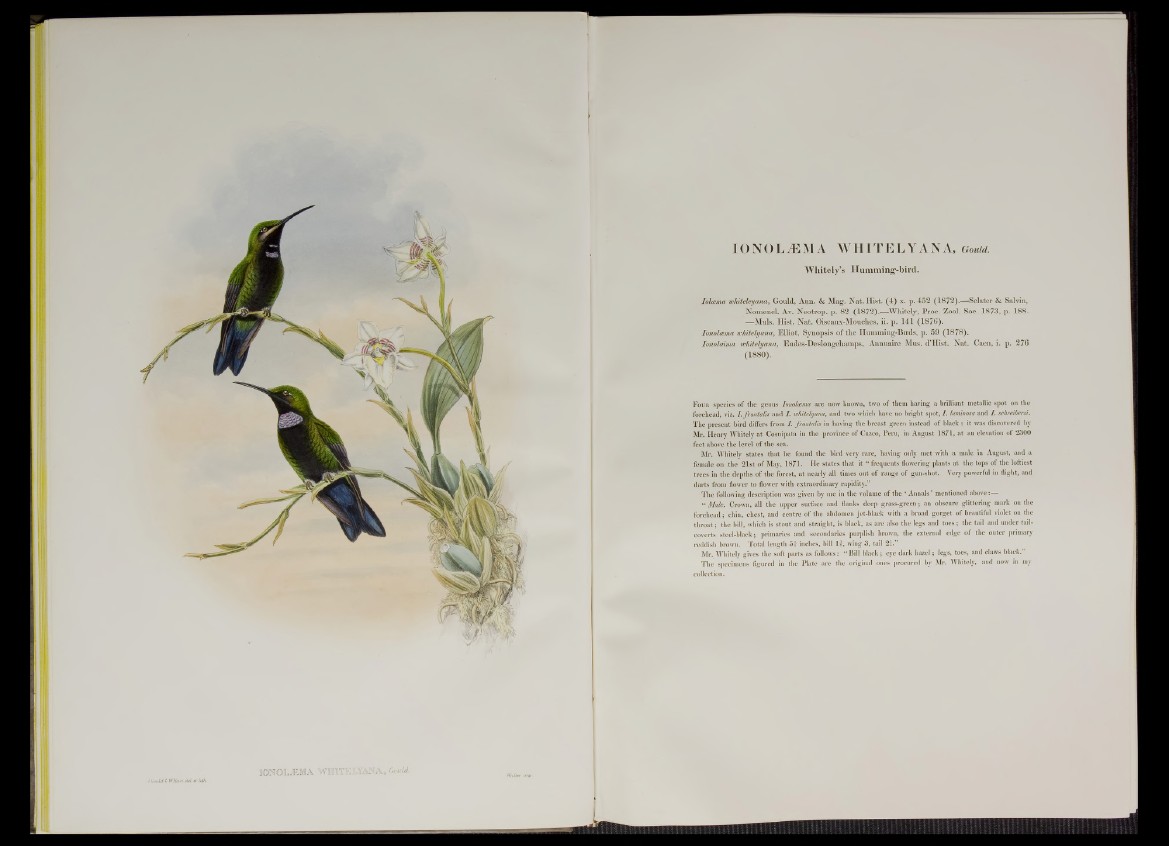
IONOÎLÆMA. WÏHTEL'îlÔBAj Grndd.
IONOLÆMA WHITELYAN A, Gould.
WhiteLy’s Humming-bird.
Iohcma whiteleyana, Gould, Aon. & Mag. N a t. Hist. ( 4 ) x. p. 4 5 2 (1 8 7 2 ).— Sclater & Salvin,
Nom encl. Av. Neotrop. p. 8 2 (1 8 7 2 ) l = -Wlntely. Proc. Zool. Soc. 1 8 7 3 , p. 1 88.
— Muls. Hist. N a t. Oiseaux-Mouches, ii. p. 1 4 1 (1 8 7 6 ).
lonoloema ic/àtehjana, Elliot, Synopsis o f the Humming-Birds, p. 5 9 (1 8 7 8 ).
Ionolaima whitelyann, Eudes-Deslongchamps, Annuaire Mus. d’H ist. N a t. Caen, i. p. 27 6
(1 8 8 0 ).
Four species o f the genus Ionolcema are now known, two of them having a brilliant metallic spot on the
forehead, viz. I. frontalis and I. whitely ana, and two which have no bright spot, / . luminosa and I. schreibersi.
The present bird differs from / . frontalis in having the breast green iustead of black : it was discovered by
Mr. Henry Whitely at Cosnipata in the province of Cuzco, Peru, in August 1871, at an elevation of 2300
feet above the level of the sea.
Mr. Whitely states that he found the bird very rare, having only met with a male in August, and a
female on .the 21st of May, 1871. He states that it “ frequents flowering plants at the tops of the loftiest
trees in the depths of the forest, at nearly all times out o f rauge of gun-shot. Very powerful in flight, and
darts from flower to flower with extraordinary rapidity.”
The following description was given by me in the volume of the * Annals ’ mentioned above:—
“ Male. Crown, all the upper surface and flanks deep grass-green; an obscure glittering mark on the
forehead; chin, chest, and centre of the abdomen jet-black with a broad gorget of beautiful violet on the
throat; the bill, which is stout and straight, is black, as are also the legs and to es; the tail and under tail-
coverts steel-black; primaries and secondaries purplish brown, the external edge o f the outer primary
reddish brown. Total length 5* inches, bill l i , wing 3, tail 2 i.”
Mr. Whitely gives the soft parts as follows: “ Bill black; eye dark hazel; legs, toes, and claws black.
The specimens figured in the Plate are the original ones procured by Mr. Whitely, and now in my
collection.